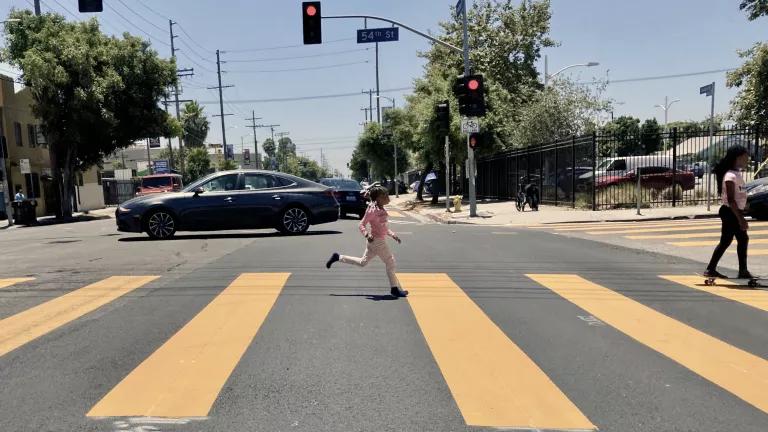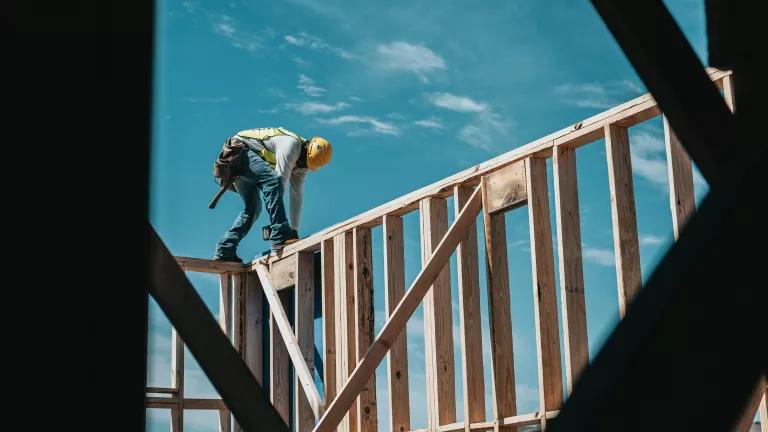Saving Lives by Delivering Safe Streets for All
The U.S. Department of Transportation provided funding for 510 Safe Streets for All projects—projects that will lead to a better, safer transportation system.

waltarrrrr via Flickr, CC BY-NC-ND 4.0
This guest blog was written by NRDC intern Brooklyn Morris.
The U.S. Department of Transportation provided funding for 510 Safe Streets for All projects this month, with $800 million to be used on projects in almost every state in the country.
With pedestrian deaths at 7,485, higher than they have been in decades, it is imperative that change is made on our nation's roads. The reason for this vast number of pedestrian deaths comes from dangerous street designs. These poorly designed roads hit Black, brown, and low-income communities hardest, yielding especially high numbers of injuries and deaths. So, while these grants are a step in the right direction, there is a lot more room for improvement, for example, by upgrading engineering standards for transportation infrastructure.
The goal of the Safe Streets for All program, put in place by the historic 2021 Bipartisan Infrastructure Law, is to upgrade roads in the United States so they’re safe for any drivers, bikers, or pedestrians that use them. According to sustainable transportation expert Angie Schmitt, until 2012, there was a similar federal program dedicated to this purpose called Safe Routes to School but it was folded into another program. Meanwhile, pedestrian deaths have soared, especially during the pandemic. The new Safe Streets for All program should help reverse that trend.
Planning funds
The overwhelming majority (473) of the grants awarded this month will be for planning future projects. A project for planning funds must have an Action Plan in place in order to be eligible. Funds can be awarded for supplemental planning activities if this Action Plan is already in place. Some of the planning activities are for the development of projects such as: planning structure, collaboration, strategy and project selections, and transparency methods. But others incorporate policy changes in the structure, including: safety analysis, equity, and policy and process changes.
I was born and raised in Ohio, so I’ll focus on the measures my home state is taking. The Mid-Ohio Regional Planning Commission (MORPC) was given a grant toward its safety action plan for the Columbus area. In 2020 alone, there were 228 fatalities and 1,484 serious injuries reported in the central Ohio area, a surprising statistic for the year since the number of cars on the road in 2020 decreased dramatically with the pandemic. This trend was consistent throughout the country with 38,680 deaths in total, which is the highest in the past 13 years.
The seven counties in the central Ohio region covered by MORPC must focus on safety because reports show that accidents and fatalities have started to rise in those areas. The funds from the Safer Streets for All program will be used to research the rise in fatal crashes and create a plan for how to reduce this number to ultimately provide safe transportation for all drivers, bikers, and pedestrians.
Implementation funds
The remaining 37 grant awards go toward the implementation of projects, which can include installing, improving, and carrying out Action Plans. Examples of this include:
- Installing pedestrian safety enhancements and closing network gaps
- Supporting the development of bikeway networks
- Carrying out speed management strategies
- Creating safe routes to school and public transit services
- Promoting the adoption of innovative technologies or strategies to promote safety
- Conducting education campaigns to accompany new or innovative infrastructure
- Evaluating and improving the safety of intersection
For example, MORPC was also granted $12 million in implementation funds for a project on the West Side of Columbus to fix up Livingston Avenue. The neighborhoods surrounding the project site have been harmed by redlining and even destruction, when freeways were built in the 1930s.

Livingston Avenue in Columbus, Ohio
Brooklyn Morris
This road, in particular, is a perfect choice for the Safer Streets for All grant because of the many crashes, injuries, and fatalities that have happened here over the years. In 2021 alone, there were 65 crashes on Livingston Avenue. Without total numbers from last year, some examples from 2022 include: In March, there was a crash around six in the morning that led to the death of the driver; in October there was a crash that left a child in critical condition at Nationwide Children’s Hospital; and in December there was a pedestrian killed.
With this federal grant, the regional planning council, in collaboration with the Ohio Department of Transportation and the city of Columbus, can and must cut the number of fatalities and injuries afflicting pedestrians and drivers on Livingston Avenue.
The Safer Streets for All grants awarded this month are a big step forward, and this is just one year of grants, from one of the programs creating changes in our transportation through the Bipartisan Infrastructure Law. These programs that are being funded will lead to a better, safer transportation system throughout American communities. While grants and investments from the infrastructure law continue to be implemented, my colleagues at NRDC and I will continue to report on these important investments.


